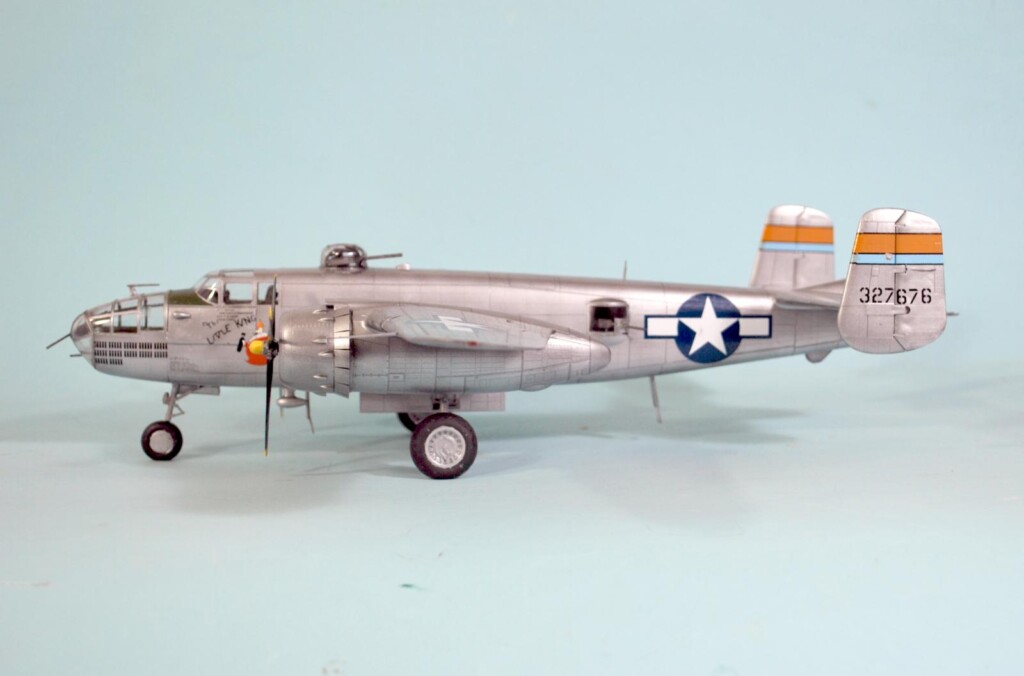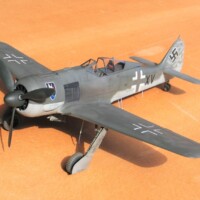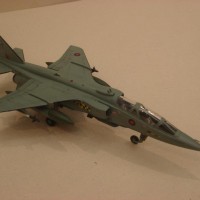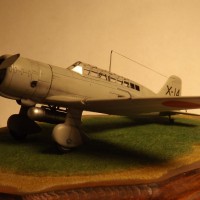Review: H-K Models 1/48 B-25J Mitchell
The Airplane:
What became the B-25 Mitchell medium bomber originated in a 1938 Army Air Corps proposal for a twin-engine medium bomber. The February 1938 proposal from North American aviation was accepted and followed by the production of the NA-40 prototype, which barely resembled what became the B-25.
The B-25 is generally considered the best all-around light-medium bomber of the Second World War. An efficient yet docile-handling aircraft with good handling characteristics, it was one of the most popular aircraft among the aircrews of the several Allied nations that operated the type. 9,816 B-25s were produced, making the Mitchell the most-produced American twin-engine bomber. While the USAAF never had more than 2,656 B-25s in service due to the fact the aircraft was operated by the RAF, the Soviet Air Force, and several other Allied air forces, it made its mark on every front of the war world-wide.
With the loss of the NA-40 prototype during tests in 1939, North American suggested that the meager test reports and the suggestions of the Air Corps as a result indicated a better aircraft could result from a redesign. The resulting NA-62, appearing in 1940, became the B-25.
The first unit to operate the B-25 was the 17th Bombardment Group, which re-equipped with the combat-capable B-25B in 1941. On December 24, 1941, a B-25 from the 17th BG became the first American twin-engine bomber to sink a Japanese submarine.
The most widely-produced sub-type was the B-25J, with 4,318 being produced at the North American Kansas City plant. Appearing in the summer of 1943, the B-25J remained in production for the rest of the war.
The 310th Bomb Group's Bad Day:
June 22, 1944 was the longest day of the year. It was cloudy that morning, with a hint of rain, and it seemed at first that flying for the day might be canceled. However, shortly after lunch, the 310th's crews were told to stand by for a mission that afternoon. The weather continued “iffy,” and the men spent the afternoon in card games, reading books, and attempts at sleep.
Finally, the crews were called for a briefing at 1600 hours. There they learned that they were going back to the Vernio rail bridges with two 18-plane formations from all three squadrons - the 379th, 380th and 381st. The target was known for “beaucoup” flak. Takeoff was set for 1700 hours, which would give them time to fly 90 minutes to Florence, make the attack and get back before dark. S/Sgt George Underwood who was set to fly that day in the 380th's “Little King” despite being in the 381st, was happy when it turned out they didn't “make the cut” for inclusion in the mission.
Just as the B-25s were lining up for takeoff, word came that the Germans in the port of Leghorn had been spotted by aerial reconnaissance preparing to tow four gutted hulks out to the southern harbor entrance, where they would be sunk to block Allied use of the harbor when it fell. The Germans had already sunk several hulks in the northern entrance, and it was necessary to prevent this since the fall of Leghorn was expected in a few weeks. A “quickie” mission was laid on, with three B-25s of the 380th, three from the 381st, and twelve from the 428th squadron, charged with sinking the hulks before the Germans could pull them out to a position where they could block the entrance. Underwood's crew was among those assigned the mission.
Veteran pilot First Lieutenant Glenn T. Black of the 381st led the mission. As he later recalled, “On this special mission, I was to lead three from our squadron, three from the 380th and twelve from the 428th. I didn't like the arrangement, for we had our best missions when the whole mission was made up of crews from one squadron. I expect the second element lead crew liked it much less.” That second element lead crew - Pilot First Lieutenant Peterson, Co-pilot First Lieutenant Lightsey, bombardier Staff Sergeant Hunt, gunner Sergeant Ptach, and tail gunner Sergeant Pizzimenti,- had just completed their tour of 70 missions. The men had already been given their orders to return to the states the next day, and their B-4 bags were packed in their tents in anticipation of the event. When Peterson's crew was detailed for the mission, all the other 380th crews said quietly to each other that they shouldn't be put on such a mission. However, no one made any direct complaint and all went out to man their aircraft. Twenty minutes after the last of the previous flights had disappeared over the horizon, the B-25s began taking off. After circling the field for join-up, the eighteen planes set off over the Tyrrhenian Sea toward Leghorn.
As the bombers neared Leghorn, the formation was scattered by clouds. Glenn Black's formation of six, which included George Underwood's “Little King,” was to bomb from 12,500 feet and to the left of the other two flights that were bombing at 8,500 and 10,000 feet. Black elected to turn wider over the Initial Point (IP), which placed his flight well behind the others. He was aiming for a three-minute bomb run, long enough for his bombardier to line up on the hulks below, while hopefully not enough time for the German gunners to get their range, though from the black puffs of 88mm shell explosions around the formations ahead it was certain the Germans were ready and waiting. Black lowered his seat so he could concentrate on the PDI (Pilot Direction Indicator) as the bombardier lined up on the target. He wasn't aware that his wide turn had added about 90 crucial seconds to their run.
In the distance ahead, flak burst all around the second formation. Suddenly the lead B-25 erupted in flame when the right wing caught fire! The Mitchell fell away in a step dive toward the harbor as the fire spread to the engine nacelle and then to the fuselage. Black silently cried out “Jump! Jump!” The bomber was now headed straight down. At the last moment, a body came out of the rear escape hatch and the parachute began to stream. It was too late and whoever it was fell all the way to the harbor below with a half-deployed parachute. The Mitchell exploded on impact with the water's surface. Lieutenant Peterson and his crew wouldn't be catching that flight home in the morning.
As if that wasn't bad enough, the second plane in the formation also took a hit in the bomb bay that set the oil system for the right engine afire and caused other heavy damage. The pilot nosed over in a dive to try and put out the flames and headed out to sea away from the exploding sky over the harbor.
In Underwood's Mitchell, Sergeant Smith crouched in the nose, his attention on Black's airplane ahead and his hand on the panel to toggle the release of his bombs. Underwood impatiently glanced over his shoulder in time to see the lead ship's bomb bay doors come open and heard Smith's call on the intercom, “Bomb doors open.” A moment later he saw the bombs began falling from the lead plane and felt the bumps as their own bombs fell clear. “Bombs Away! Bomb doors closing,” Smith announced. “Let's get the hell out of here!”
Black now realized his formation was too far from the other twelve to join up for evasion. As the other three airplanes maneuvered to follow Black, the Germans got the range in a series of lucky shots. “We took a close burst just ahead of the right wing outboard of the engine, and it was very quickly apparent the engine had taken the worst of the hit when smoke poured out of the cooling flaps,” Underwood later remembered.
In the lead ship, Black felt his whole plane seem to stand still and shudder in midair as several shells exploded close by. “I looked down at my right hand, which had been on the throttles - it lay limp in my lap. I looked down at my right arm and could see the jagged end of the lower part of my bone in my upper arm and the jagged ends of the bones in the lower part of my arm. My elbow was no more. My lower arm reminded me of the drumstick of a freshly-butchered chicken. The only connecting flesh I could see holding my lower arm looked like raw meat. I turned the controls over to my co-pilot, but he pulled up straight and level so I took over again and did evasive action one-handed that was probably more violent than was necessary.” Once clear of the flak, he gave control back to the co-pilot and called the bombardier to give him first aid.
“The Little King” broke left out of the formation when it was hit in the right engine and dove for the open sea. A second “88" burst near the left wing. The pilot feathered the right engine and took up a heading for Corsica. Underwood kept his eyes on the left “good” engine as white smoke from burning oil appeared out of the cowling flaps.
Over the Tyrrhenian Sea in the fading light, Underwood thought they might make it when Sergeant Smith's voice came over the intercom, “Corsica dead ahead.” Soon they were over Ghisonaccia Airfield, with a green flare for landing.
Those waiting on the ground heard the approaching roar of the B-25s returning from the mission. Sunset light glinted off canopies and bombardier greenhouses and turrets as the Mitchells came overhead and broke for landing. Red flares shot out from several, indicating wounded aboard. The ambulance drivers started their engines. Shaken crews emerged from the planes with reports of heavy, accurate, “beaucoup-beaucoup” flak in the target area, with continuous flak bursts among the formations. Everyone marveled at the seemingly-miraculous fact that no one had been killed other than the one crew lost over the target. When “The Little King” landed, 380th maintenance sergeant Frank Dean examined the airplane for new flak holes. “A small hole was found right beneath the bombardier's compartment, where it had been stopped by an extra piece of armor plate we had installed for just such purpose. Had it not been in place, there could have been a fatality. Most of the other aircraft bore mute evidence of the accuracy of the German gunners.”
The 380th squadron had lost one B-25, with all aboard killed, while the 381st lost two B-25s of three with no fatalities and all crew rescued. The hulks were sunk away from the harbor entrance.
The missions to the Vernio bridges had knocked out the approach to the southern bride and one span of the northern bridge. Crews reported the flak was worse than expected and every airplane had some damage though no crew wee lost.
The Kit:
H-K Models' 1/32 B-25s are considered the mot accurate kits of the Mitchell. This new 1/48 kit is a scale down of those, with some simplification in assembly such as a one piece engine cowling. The surface detail is as good as the larger models, executed in a very petite manner. The kit provides a shaped metal weight that fits under the flight deck and provides the bombardier's tunnel, a welcome addition since getting a B-25 model to nose-sit can be problematic.
Decals are provided for two aircraft, a B-25J modified to a “strafer” of the 345th “Air Apaches,” in OD/NG camouflage, and a NMF B-25, “She's Enough” of the 380th squadron of the 310th bomb group in 1945.
The review kit I received did not have decals, so I used SuperScale 48-784, which has “The Little King” as an option. I had wanted to do a model of this airplane because both of my 57th Bomb Wing friends, bombardier Sterling Ditchey and flight engineer/turret gunner George Underwood, who passed away within 10 days of each other in October 2021 and were of great help in researching my book “The Bridgebusters: The True Story of the Catch-22 Bomb Wing” had flown missions in the airplane.
Construction:
The instructions are clear, and this project was not that much more difficult than building a Monogram B-25. All parts fit very precisely; if one takes care in assembly, there will be very little seam-filler needed, and that which you will use will be minimal. The instructions are clear and my only advice in building the kit is to study them and then follow them. If you do this, all will be fine at the end.
I built the kit in four sub-assemblies: fuselage, tail empennage, left and right wings. I found that, like the 1/32 kits, the tabs above and below the wing attachment spars on the fuselage need to be thinned down about 1/3, so the wing can slide back into position without having to use so much force one would risk injury to the model. Unlike the 1/32 kits, which I had done without gluing the wings so they could be removed for storage, I glued the wings on here. However, if you have a lack of space, you can keep the wings removable and store the kit that way when not displayed.
I painted the cockpit Dull Dark Green and the rest of the forward interior in Interior Green. The interior of the aft fuselage was unpainted aluminum, for which I used Tamiya XF-16 Flat aluminum. Modelers should note that the interior of the bomb bay and the bomb bay doors are also unpainted aluminum on the B-25J.
I used the photoetch instrument panel from the Eduard B-25D set, which fit perfectly. Eduard will release a photoetch detail set for this kit in March. I also used Eduard seat belts. I did not attach the wooden ammo bins in the forward fuselage, since the Corsica bombers had the package guns removed to save weight.
Once I glued the fuselage together, I saw it needed extra help to get a tight fit so I rubber-banded it tightly and let it set up overnight. This way, I didn't have a centerline seam to deal with and only had to scrape away a little excess dried glue. Everything fits so well with this kit that if you take care in assembly, you will need no putty or filler.
I attached the wings and rubber banded them around the engine nacelles across the fuselage to get a tight fit.
Painting:
I painted the anti-glare areas Tamiya Flat Green, since these are Medium Green on the real thing. I masked those areas and then painted the entire model with Tamiya X-18 Semi-gloss Black, which I allowed to dry for 24 hours. I then painted them model with Vallejo “aluminum,” misted on to get “good enough” coverage. I mean to differentiate that I didn't go for “thorough” coverage, because letting some of the black become noticeable under a thinner covering of Aluminum gives a good approximation of “weathering” for an unpainted aluminum surface, for oil and dirt stains. It also allows the riveted detail to “pop out” so you can see it since it is so petite.
Decals:
I applied the decals using Solvaset and they went down without problem.
Final assembly:
I attached the wheels and props, inserted the top turret, added the gun barrels to the various weapons, and called it done.
Overall:
This is really a very nice kit and is far superior to the now 50-year old Monogram kits. Look for internet bargains and you should be able to find it for $90-$100. It is worth the price difference of the old Monogram kits if you want good accuracy and detail.















Looks great! I've been interested in this since I saw it was coming out on "The Modeling News" a few months ago. Looks like it's a winner!
Nice work, Tom. Looks like a great kit.
Excellent result, Tom @tcinla
The way you applied the aluminum color resulted in a nice effect of the surface.
Definitely a kit which has gone up in my wish list.
Excellent result, Tom, together with equally excellent accompanying article!
Great looking build Tom, @tcinla. Great story showing the heroism and horrors of the crews who flew these and other aircraft during the war. I am excited about your review of this kit, but can't justify the cost with the kits I have in my stash. That said, when the solid nose version comes out...I may just have to break down and get one. Yours looks great!
Shades of Catch 22 in that story. A lovely result, the Mitchell does look good in NMF and you've captured it superbly.
@christopher - The 310th Bomb Wing, along with the 340th and 321st wings, were the 57th Bomb Wing. They ARE the Catch-22 wing. Heller flew in the 340th group.
Great clear build! fantastic metall finish! One of my fawourite planes!
Great article and very nice kit! I have the Revell version and I think this merits a replacement. Great story of the MTO where my old man escorted these guys out of Corsica. Much neglected by historians usually. Not much sexy air to air combat I guess by that time! Message to self. Buy Tom's book!
@ross4 - the book has even been reissued this past fall. You can get it on Amazon. $17.60/
Done!
Excellent build and history behind the build.
Amazing metal finish, love how it looks weathered and flat in different places!
Nicely done, Tom. Though a "simple" technique on the metal finish, it really came out looking good.
Thanks for posting Tom you are an inspiration. One day I might do "King Nine" from the Twilight Zone.
Super build Tom, great text with good info 👍 with the HK release I assumed that some modellers would pass up the Accurate miniatures version and I was lucky enough to pick one of those up for £20.00 so nice one all round 😊
Gorgeous results Tom, the look of the simple but well applied Vallejo is surely aided by the exquisite surface details of the kit.
@tcinla, That's very nice Tom! 👍 It sounds like a great kit and your results confirm that. Seems like it's time to retire the old Monogram kit after its long run. 😃
Beautifully done, as always!
You set the bar high for us, and that's good, it gives us something to strive for!
Well done!
The B-25 stands wonderfully voluminous and impressive on its landing gear - a captivating sight. Congratulations! A great model also with regard to the really successful natural metal finish!
She's a beauty! Like many no doubt, the B-25 is one of my favorite WWII aircraft. Just such a distinctive look and healthy history, especially in the Pacific.
A beauty of a model and an interesting story behind it. I always enjoy your builds and history lessons!
Superbly beautiful, TC @tcinla. Enjoyed the history. Another kit to add to the list.
I applaud your NMF, and appreciate your technique. I have several kits waiting for a NMF, but I really don't enjoy the experience. Perhaps there is hope.
@plasticslave - Vallejo is about as pain-free as you can get with metalizer.
Am in the process of switching over to Acrylics as my stash of MM enamels is dwindling. Chose Vallejo for a number of reasons.
I've had my eye on this kit. Perhaps another attempt at a NMF? I would be happy if it turns out half as good as yours. Well done! And great story!
Great looking Mittchell!
Hello Tom, @tcinla
I'm sorry I missed this one. My wife and I have been sick and I have not been on Imodeler in a Month now. Today was the first time. I have a lot of catching up to do.
I especially enjoyed reading the story behind this plane. This is what drives me to build the ones I do. These guys need their story told, and you have done a great job with it.
My Dad's Cousin was killed in a B-25J named "Evora" over the Galliate Bridge in Italy, and he's still there in the US Military Cemetery in Florence.
He flew 57 missions over Italy trying to knock out the bridges and such. He flew a lot of missions in this B-25 named "Blonde Beauty". I have documentation he flew at least 10 times in this plane. Someday I will try to cobble together some decals for it. I built one as "Stuff". He flew several missions in her too.
He was a top turret gunner with the 345th BS, 321st BG. We have talked about this a lot in the past. Every time I see a B-25 I think of him, and another lost family member who was named Thomas Smith. If you look close you can see the B-25 image on his grave memorial marker. The bottom line is a bit hard to read, but it says "Lost Somewhere in Sulu Sea". This area is not too far from the Marianna's Trench and the waters are VERY deep here.
Lt. Smith was a B-25J pilot in the Pacific and he flew with the 42nd Bomb Group, part of the "Crusaders" 100th BS in the Philippines who was killed on April 8th, in 1945. They never recovered his body and he is still buried somewhere deep in the Sulu Sea if the sharks didn't eat him. The Unit Commander was teaching his newer pilots how to do skip bombing and how to evade a ship's AAA at low levels.
His Commander started a "Split S" and his altitude was too low when they flew into clouds and disappeared never to be seen again. Afterwards, other planes in the group saw the wreckage in the water, and floating debris, but no survivors. The Unit Commander who was also the pilot in command of the plane was also named Smith, but he was a Lt. Col. He and 7 new pilots were killed in this one plane when it hit the water. My Dad's Cousin was one of them, all of them killed on a "routine" training flight.
I have since located a set of "Crusaders" decals to build a B-25J for him too, and since I know the aircraft's serial number I should be able to cobble something together for him as well.
Someday I will build another B-25 tribute build for him like I did for Tommy Bricen when I built "Stuff", but I want this one to be the "Blonde Bomber".
Thanks for keeping their story alive. I definitely clicked on the "like" button.
Always like your builds and articles Tom.
Maybe if I sold all 11 of my Monogram kits I could buy one or two of these, but I do love the old dears.